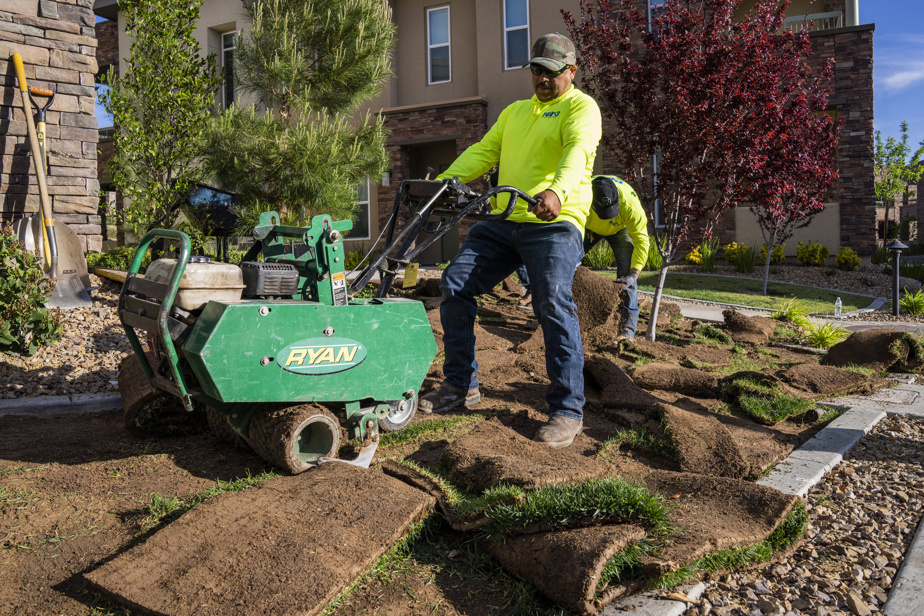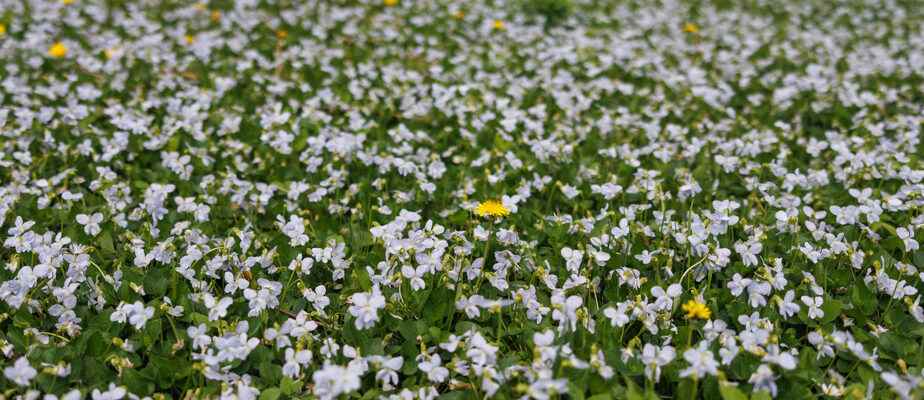The scene caused a stir in the United States: entire lawns uprooted in Las Vegas to avoid wasting water. In Quebec, the City wants to limit the watering of flowerbeds. And in a recent manifesto, the Family Farmers call for replacing green grass with aromatic, medicinal, bee-producing or vegetable plants. Tough time for the lawn? It is however easy to make a green gesture… by accepting that it is less so.
Posted at 12:00 p.m.
“People really want to help, and are wondering what to do” to help the planet, notes Émilie Viau-Drouin, president of the Cooperative for ecological local agriculture, in the wake of the publication, together with the Family Farmers , of Resilience Manifesto, which pleads among other things for less uniform flowerbeds. “Precisely, you can start by adding plants to your lawn that help biodiversity. It’s not nothing, it’s a huge gesture! »

PHOTO DENIS GERMAIN, SPECIAL COLLABORATION
At the Botanical Garden, the dandelion now grows freely, to the point of forming a dense yellow carpet between the tulip beds.
And the best thing about it is that this gesture can be limited… to doing nothing. An approach advocated by Joshua Jarry, horticultural information officer at the Botanical Garden. “The easiest way to promote biodiversity is to let things go,” he says. Beautiful plants can appear on their own, then reseed year after year, such as the Virginia strawberry plant, with its pretty white flowers, forget-me-nots, different varieties of violets, clover, plantain, wild parsnip… and dandelion, of course. »
At the Botanical Garden, the dandelion now grows freely, to the point of forming a dense yellow carpet between the tulip beds. “It’s perfect for helping winter-starved pollinating insects to feed themselves,” adds Joshua Jarry, noting in passing the Dandelion Challenge (called “No Mow May” among English speakers), which invites you to delay the mowing of the yellow flower in order to come to the aid of the bees at the time of the year when they are most vulnerable. Adding white clover to your lawn will also help pollinating insects.
A culture to change
The obsession with the uniform lawn is “a question of culture”, recalls Émilie Viau-Drouin. A culture that sometimes leads to absurdities, like growing it in the middle of the desert.

PHOTO JOE BUGLEWICZ, THE NEW YORK TIMES
Workers remove entire lawns from a Las Vegas lot.
Faced with dangerously low water supplies in the midst of a drought, Nevada passed a law last year to ban grass and replace it with plants better suited to the arid climate. Also grappling with shortages of drinking water, the City of Quebec will limit the watering of lawns to two evenings a week during the summer, and to only one evening as of next year.
However, municipalities are still often the ones who slow down the abandonment of lawns, by limiting the height of tolerated plants and by prohibiting the development of vegetable gardens in front of properties, for example.
“It’s absurd,” says Elisabeth Cardin, a former restaurateur (Manitoba) who wrote the Resilience Manifesto. “If you care about the health of your community, it should be the opposite. “Cities and boroughs could thus encourage the abandonment of lawns thanks to subsidies, she believes. “It takes time and money to uproot a lawn. »
-

PHOTO DENIS GERMAIN, SPECIAL COLLABORATION
Wild thyme, a very dense and fragrant ground cover
-

PHOTO DENIS GERMAIN, SPECIAL COLLABORATION
Forget-me-not, with its cute bluish flowers, proliferates in the shade of trees.
-

PHOTO DENIS GERMAIN, SPECIAL COLLABORATION
Common violets in bloom in the middle of the lawn of the Botanical Garden
-

PHOTO DENIS GERMAIN, SPECIAL COLLABORATION
Virginia strawberries, which will produce edible berries prized by birds
-

PHOTO DENIS GERMAIN, SPECIAL COLLABORATION
The figwort, a very invasive plant that grows particularly well under trees
1/5
The gradual transition
One thing is certain, before tearing everything out, it is better to check what the regulations in place provide, recalls Joshua Jarry, who also advises to get along with his neighbors, because the plants grow without worrying about fences. Trained in biology at McGill, he also encourages those who prefer to get rid of their lawn to plan a gradual transition.
“I don’t really like the idea of replacing one monoculture with another,” he says. It is best to reduce your lawn gradually, to see what grows well on each ground, depending on the soil and the amount of sunshine. Thyme, for example, takes years to establish. Better to plant some in a corner to start with. »
Digging a few flowerbeds or laying tubs on the lawn to practice an above-ground vegetable garden also seems to him to be great ways to gradually move away from the lawn without spending a fortune… or risking too much disappointment.

PHOTO DENIS GERMAIN, SPECIAL COLLABORATION
Joshua Jarry, from the Botanical Garden
Nothing resists trampling as well as grass, not even white clover or thyme, the two star alternatives, you should know.
Joshua Jarry, from the Botanical Garden
There are also plants that should not take the place of the lawn, because they risk getting out of control, adds the attendant. Among them, the very aggressive mint, the false buttercup, the ground ivy and the false rapunzel bellflower, despite its pretty little bell-shaped purple flowers.
The first thing to do to get started, recommends Elisabeth Cardin, is to get inspired by visiting a garden center, especially if it specializes in native plants. Joshua Jarry, for his part, directs people to the Garden’s Horticultural and Botanical Notebook, which contains a ton of up-to-date information, including ground covers, native plants and those that grow wonderfully in flower gardens.
Taking a new look at your lawn can lead to a broader and necessary reflection, believes Elisabeth Cardin, at a time when everyone must begin an ecological transition. Rather than seeing your lawn as an “object to be maintained”, she says, we should see it as something “living that can help us better understand our relationship with nature”. “When this sensitivity is developed, we can no longer remain insensitive to the agricultural cause, to where everything we eat comes from,” she concludes.
Go to the Botanical Garden
The 25thand The Botanical Garden’s Great Gardening Rendez-vous will be held in person next weekend in Montreal. Visitors will be able to meet, from May 27 to 29, some forty exhibitors, including local producers who will offer plants and advice on ecological gardening.

